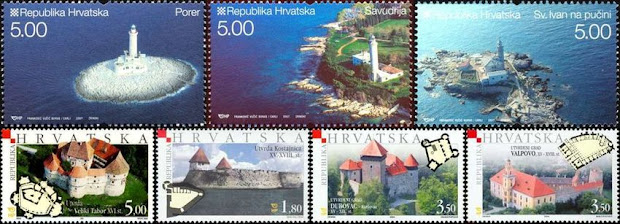The Bishop's palace that encircles the cathedral of Zagreb is an interesting sight. Build in the 15th century, it not only provided the clergy with accommodation, but was also designed to keep the Turks out. Therefore, the palace resembles a fortress.
 We can only guess how the interior looks like, as the premises are firmly closed to visitors. A shame, if you ask me, but not uncommon in Zagreb. Other cities would gladly share their beauty with tourists (and charge them for it, of course) but Zagreb prefers to keep them out. Tourists are considered the Turks of the 21st century. Not surprising that Zagreb was chosen as one of Europe's most boring destinations.
We can only guess how the interior looks like, as the premises are firmly closed to visitors. A shame, if you ask me, but not uncommon in Zagreb. Other cities would gladly share their beauty with tourists (and charge them for it, of course) but Zagreb prefers to keep them out. Tourists are considered the Turks of the 21st century. Not surprising that Zagreb was chosen as one of Europe's most boring destinations.
 A little street runs along the base of the low hill on which the cathedral stands, called Vlaška ulica. The adjective "vlaška" comes from the noun "Vlah", the name used for descendants of Roman colonists in the Balkans. As Romanians are the only Balkan people that speak a Roman language, the word Vlach became associated with Romanians, and especially with Romanians living outside of Romania.
A little street runs along the base of the low hill on which the cathedral stands, called Vlaška ulica. The adjective "vlaška" comes from the noun "Vlah", the name used for descendants of Roman colonists in the Balkans. As Romanians are the only Balkan people that speak a Roman language, the word Vlach became associated with Romanians, and especially with Romanians living outside of Romania.
In Croatian, however, the them Vlah was used for foreigners in general, and Italians in particular. Foreigners in Zagreb lived mostly at the foot of the Bishop's palace, just outside of the walls. That is how Vlaška ulica got it's name. It is a street for strangers.
 Vlaška is one of Zagreb's oldest streets. The small houses look humble but cute next to the thick towers of the palace and the spires of the cathedral. Precisely this part of the street is in a terrible condition. The houses have been deserted, the doors and windows barricaded, the walls are crumbling. The foreigners are long gone. Zagreb's history is falling apart.
Vlaška is one of Zagreb's oldest streets. The small houses look humble but cute next to the thick towers of the palace and the spires of the cathedral. Precisely this part of the street is in a terrible condition. The houses have been deserted, the doors and windows barricaded, the walls are crumbling. The foreigners are long gone. Zagreb's history is falling apart.
 We can only guess how the interior looks like, as the premises are firmly closed to visitors. A shame, if you ask me, but not uncommon in Zagreb. Other cities would gladly share their beauty with tourists (and charge them for it, of course) but Zagreb prefers to keep them out. Tourists are considered the Turks of the 21st century. Not surprising that Zagreb was chosen as one of Europe's most boring destinations.
We can only guess how the interior looks like, as the premises are firmly closed to visitors. A shame, if you ask me, but not uncommon in Zagreb. Other cities would gladly share their beauty with tourists (and charge them for it, of course) but Zagreb prefers to keep them out. Tourists are considered the Turks of the 21st century. Not surprising that Zagreb was chosen as one of Europe's most boring destinations. A little street runs along the base of the low hill on which the cathedral stands, called Vlaška ulica. The adjective "vlaška" comes from the noun "Vlah", the name used for descendants of Roman colonists in the Balkans. As Romanians are the only Balkan people that speak a Roman language, the word Vlach became associated with Romanians, and especially with Romanians living outside of Romania.
A little street runs along the base of the low hill on which the cathedral stands, called Vlaška ulica. The adjective "vlaška" comes from the noun "Vlah", the name used for descendants of Roman colonists in the Balkans. As Romanians are the only Balkan people that speak a Roman language, the word Vlach became associated with Romanians, and especially with Romanians living outside of Romania.In Croatian, however, the them Vlah was used for foreigners in general, and Italians in particular. Foreigners in Zagreb lived mostly at the foot of the Bishop's palace, just outside of the walls. That is how Vlaška ulica got it's name. It is a street for strangers.
 Vlaška is one of Zagreb's oldest streets. The small houses look humble but cute next to the thick towers of the palace and the spires of the cathedral. Precisely this part of the street is in a terrible condition. The houses have been deserted, the doors and windows barricaded, the walls are crumbling. The foreigners are long gone. Zagreb's history is falling apart.
Vlaška is one of Zagreb's oldest streets. The small houses look humble but cute next to the thick towers of the palace and the spires of the cathedral. Precisely this part of the street is in a terrible condition. The houses have been deserted, the doors and windows barricaded, the walls are crumbling. The foreigners are long gone. Zagreb's history is falling apart. 




0 reacties:
Post a Comment